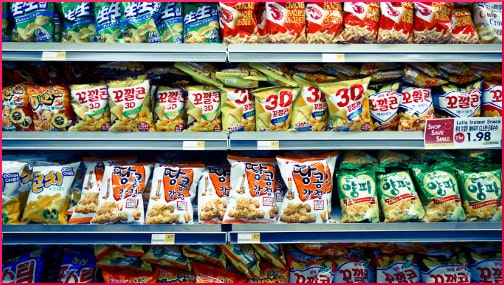
Recently, Childhood Obesity News started looking back over the past five years of food marketing, to see if any trends can be spotted, or just in case we missed anything that later turned out to be significant.
Part of the overall problem is that, even when the public wins a victory, like requiring manufacturers to list ingredients and nutritional information on food packaging, the average person’s patience for decoding the stats is practically zero. Who has time to stand around in a supermarket, reading tiny print with a magnifying glass? Even if a grownup has a smartphone and the ability to look online for the relative healthfulness of products, who can manage that when meanwhile, the kids are in another aisle, throwing apples at each other?
Many times, the description of a scientific study is too technical for a person to absorb quickly and easily. Thomas Riggins provided a clear, uncomplicated report of work done at the University of Liverpool back in 201l to determine whether commercials for unhealthy foods actually influenced kids. The subjects were between six and 13 years of age. Some watched five minutes of toy commercials, then a cartoon. Others watched five minutes of commercials for snacky pseudo-foods.
Then, all the kids were offered a range of healthy and unhealthy foods, including well-known brands. The group that had watched the food commercials were noticeably more apt to choose edible junk, while the toy commercial group chose less. This type of experiment sounds elementary, because it shows something that most people intuitively realize, even if they manage to keep that knowledge tamped down in their subconscious.
But before manufacturers can be admonished about their advertising habits, and before meaningful laws can be proposed, official test results need to be presented. Study co-author Emma Boyland said:
Our studies highlight that there are global connections between advertising, food preferences and consumption. This is a beyond brand effect, increasing children’s selections of all unhealthy foods — not just those shown in the adverts.
In that paragraph, a certain phrase sticks out like a sore thumb — the researcher’s assertion that this is a “beyond brand effect.” It often seems as if the major food corporations are not really in competition at all, but are joined in a weird cabal based on the old saying, “A rising tide lifts all boats.”
Again and again, researchers find that commercials stir up cravings, not so much for any particular brand or item, but just for something to shove in the old pie-hole. It is easy to theorize that, deep down, the various companies don’t even really care what effect a particular commercial has on their own bottom line, because a greater principle is in operation.
Company A knows that its commercials will stimulate the consumer to buy or eat something — even if it is from Company B. Meanwhile, Company B knows that its marketing efforts will inspire the consumer to buy or eat something — and even if, this time around, it happens to be Company A’s product, it doesn’t matter. In the long run, it all evens out, with all the Big Food corporations benefitting from all the advertising.
Even though they ostensibly compete against each other, each company rests secure in the knowledge that it will reap its share of profit — if not on this shopping trip, certainly on the next. Each company only needs to contribute to the general amount of craving and the ever-increasing number of addicts, and all the companies win. The only loser is the customer.
Your responses and feedback are welcome!
Source: “Major food companies promote childhood obesity,” PeoplesWorld.org, 08/18/11
Photo credit: Benson Kua via VisualHunt/CC BY-SA

 FAQs and Media Requests:
FAQs and Media Requests: 











